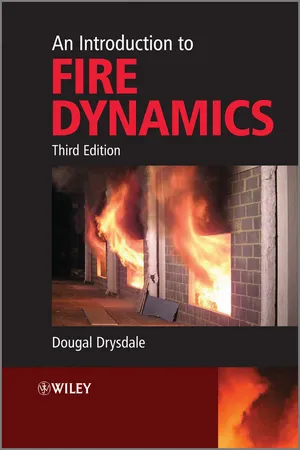
- English
- ePUB (mobile friendly)
- Available on iOS & Android
An Introduction to Fire Dynamics
About this book
"Drysdale's book is by far the most comprehensive - everyone in the office has a copy...now including me. It holds just about everything you need to know about fire science."
(Review of An Introduction to Fire Dynamics, 2 nd Edition )
After 25 years as a bestseller, Dougal Drysdale's classic introduction has been brought up-to-date and expanded to incorporate the latest research and experimental data. Essential reading for all involved in the field from undergraduate and postgraduate students to practising fire safety engineers and fire prevention officers, An Introduction to Fire Dynamics is unique in that it addresses the fundamentals of fire science and fire dynamics, thus providing the scientific background necessary for the development of fire safety engineering as a professional discipline.
An Introduction to Fire Dynamics
- Includes experimental data relevant to the understanding of fire behaviour of materials;
- Features numerical problems with answers illustrating the quantitative applications of the concepts presented;
- Extensively course-tested at Worcester Polytechnic Institute and the University of Edinburgh, and widely adopted throughout the world;
- Will appeal to all those working in fire safety engineering and related disciplines.
Frequently asked questions
- Essential is ideal for learners and professionals who enjoy exploring a wide range of subjects. Access the Essential Library with 800,000+ trusted titles and best-sellers across business, personal growth, and the humanities. Includes unlimited reading time and Standard Read Aloud voice.
- Complete: Perfect for advanced learners and researchers needing full, unrestricted access. Unlock 1.4M+ books across hundreds of subjects, including academic and specialized titles. The Complete Plan also includes advanced features like Premium Read Aloud and Research Assistant.
Please note we cannot support devices running on iOS 13 and Android 7 or earlier. Learn more about using the app.
Information
Table of contents
- Cover
- Title Page
- Copyright
- Dedication
- About the Author
- Preface to the Second Edition
- Preface to the Third Edition
- List of Symbols and Abbreviations
- Chapter 1: Fire Science and Combustion
- Chapter 2: Heat Transfer
- Chapter 3: Limits of Flammability and Premixed Flames
- Chapter 4: Diffusion Flames and Fire Plumes
- Chapter 5: Steady Burning of Liquids and Solids
- Chapter 6: Ignition: The Initiation of Flaming Combustion
- Chapter 7: Spread of Flame
- Chapter 8: Spontaneous Ignition within Solids and Smouldering Combustion
- Chapter 9: The Pre-flashover Compartment Fire
- Chapter 10: The Post-flashover Compartment Fire
- Chapter 11: Smoke: Its Formation, Composition and Movement
- References
- Answers to Selected Problems
- Author Index
- Subject Index